

Note: this article was published in a slightly different form in Art Access, and Leschi News.
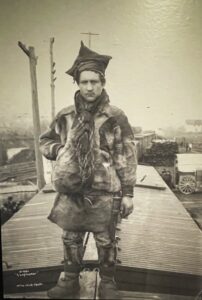
Sámi reindeer herder, Woodland Park, 1898 photographed by Anders Beer Wilse
Mygration : Tomas Colbengtson and Stina Folkebrant
National Nordic Museum until March 5
Did you know that Rudolf, the celebrity reindeer of Santa’s sleigh would have to be a female. Male reindeers shed their antlers in the winter. This is one of the many facts I have learned in order to understand “Mygration” a new exhibition at the National Nordic Museum.
In March 1898 Woodland Park visitors would have seen a surprising sight: Sámi reindeer herders and their reindeer. They came from what was then called Lapland, in Scandinavia, on a contract to teach reindeer herding to Alaskan natives! The expedition had the dramatic title of the “Lapland-Yukon Relief Expedition.”
“Mygration” addresses a strange plan to bring 100s of reindeer and Sámi herders from “Lapland” (now Sápmi ) to Alaska in order to “civilize” Native tribes there ( then called Eskimos, now Inuit and Yupik) . It was the misguided plan of Sheldon Jackson, General Agent of Education in Alaska. He spread the idea that Alaskan Natives were starving. He had first tried to bring in a much smaller number of reindeer and herders from Siberia in 1893 , across the Bering Straits, a much shorter trip!
But that effort failed.
So in 1898 he declared, as the Alaska Gold Rush was at its peak, that the Gold Miners were starving, as a ploy to raise money. The Gold Miners were devastating the environment ( the topic for a separate show, and something we never hear about) and local food gathering was in a decline, but no one was starving.
Jackson’s real agenda was actually part of the late 19th century efforts to “civilize” and assimilate Native peoples-in this case the Alaskan natives, who had not been touched by the boarding school and other policies in the lower 48 states.
Like the Alaskan natives, the Reindeer were also to be domesticated, to be used as draught animals as well as providing food.( Someone pointed out to me that Santa Claus was using reindeer as draught animals!)
It was a very long trip from Sapmi territory ( as it is now known) and Alaska!
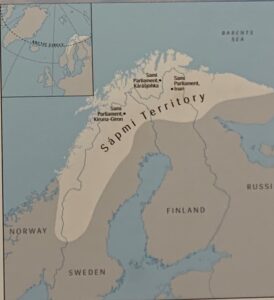
Initially the expedition included 87 Lapps (now called Sámi), some Fins and Swedes and 530 reindeer. The Sámi were touted as “model” Indigenous people as they travelled across the sea and across the country.
By the time they reached Seattle many of the reindeer died of starvation because their diet of lichen was not available.
They stopped in the Woodland Park, perhaps for the reindeer to eat, but not surprisingly, the grass didn’t suit them.
The first small gallery of the exhibition features several photos of the Sámi by Anders Beer Wilse. In one they are disembarking from the long train ride, in another about twenty herders (it isn’t clear if that was all that survived), pose along with their families, including very young children and a few Swedes who came along.
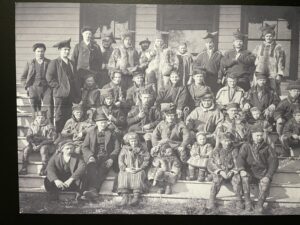

The herders stand out in their distinctive crown-like hats and clothing made of reindeer hide.
Also in this gallery is Sheldon Jackson’s, Report on Introduction of Domestic Reindeer into Alaska, and Wilhelm Basi’s ( a cook on the expedition) Diary, 1897 – 1946
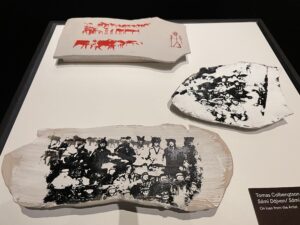
In this first gallery, don’t miss the small ceramic works by Tomas Colbengston, a Sámi artist works include two examples of photo transfer with historic Sámi images (the artist collects them). He is South Sámi and grew up in a tiny village in central Sweden. The third ceramic work depicts the reindeer, and a rendering of a figure perhaps based on a ritual drum (one of which you can also see elsewhere at the Nordic Museum).
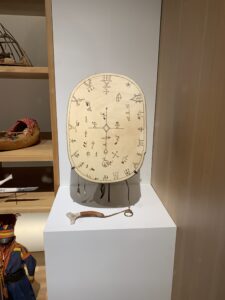
In the second gallery life size paintings of reindeer by Stina Folkebrant surround us.
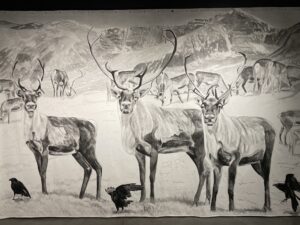
The artist is inspired by Chinese ink brush paintings: all of the paintings are in shades of gray. Her focus is the relationships of animals and humans and here indeed we feel that we are wandering in a field of reindeer.
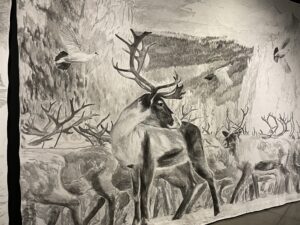
Each large painting presents a one of the eight seasons of the Sámi mountain year. We feel the powerful presence of the reindeer as we gaze back at them in the gallery. We can sense the artist’s deep feeling for her subject.
But climate change is affecting these cycles and the reindeer. As the artist told me on email:
“time is circular that is the seasons, something that returns over and over again. We also think about time as the past , present and the future. The past meets the present in our exhibition.
Climate change affects the reindeer herding because the winters are warmer and the snow melts and then it gets really cold and the ice prevents the reindeers from eating so they starve and die. The seasons are changing and that’s a problem also when the reindeers are giving birth to calves in springtime. If its to cold they die and if there is no food… etc. So climate change affects reindeer herding a lot when the seasons change.”
As described by Alaska writer Vivian Scott “Both male and female reindeer grow antlers. In early December, after mating season, male reindeer shed their antlers (unless they’re castrated males, then their antler growth has a similar cycle to female deer). Pregnant females retain their antlers throughout winter until spring.”- (Capitol City Weekly). Thus Rudolf was a female!
Her article includes many other fascinating facts about reindeer such as “Reindeer antlers are the fastest growing ‘bones’ in the world, growing up to ¾ inch per day. Reindeer have the largest and heaviest antlers of all deer species.”
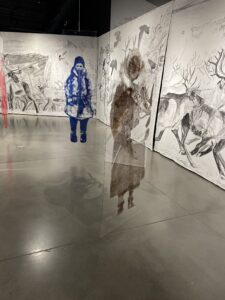
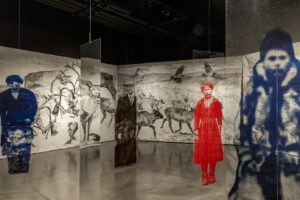
Hanging in the center of the gallery are transparent plexiglass panels as well as a panel with a mirror in the center all suspended from the ceiling. Sámi photographs have been printed onto the plexiglass by Colbengston. Herders seem to move among the life size reindeer in the paintings. We are also reflected in the mirror in the center and become part of the movement.
The artists also state in the exhibition that they are evoking the Sámi concept of herd mentality
Reindeer are herd animals and being together offers protection from danger. The whole herd becomes a single organism with a thousand eyes that can detect danger; if one turns around, the others follow. People are also herd animals; they want a sense of belonging.
The story of the Sámi and the reindeer in Alaska follows many twists and turns, with various odd power plays, including being taken over by a Gold Rush family, but in 1937 the Alaska indigenous people were given ownership of the herds from the Sámi ( we are good at taking things away from people) . Alaska natives mostly didn’t like herding which required them to be away from home for months at a time, although one woman was famous for her success. They let them go to join their caribou cousins.
In other words instead of assimilation to white man’s ways, they assimilated the reindeer to their own habitat.
Some Sámi stayed in Alaska and intermarried with the Indigenous people. They are still very much part of Alaska today as evidenced in a recent exhibition in Juneau.
“Mygration” is a celebration, not a documentation of the next parts of the story. As the moving plexiglass images of the Saami intersect with the reindeer the installation perfectly conveys the magic of nomadic herders of reindeer.
National Nordic Museum
Until March 5, 2023